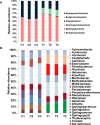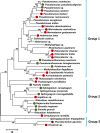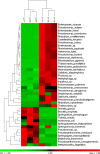Impact of Soil Salinity on the Structure of the Bacterial Endophytic Community Identified from the Roots of Caliph Medic (Medicago truncatula)
- PMID: 27391592
- PMCID: PMC4938511
- DOI: 10.1371/journal.pone.0159007
Impact of Soil Salinity on the Structure of the Bacterial Endophytic Community Identified from the Roots of Caliph Medic (Medicago truncatula)
Abstract
In addition to being a forage crop, Caliph medic (Medicago truncatula) is also a model legume plant and is used for research focusing on the molecular characterization of the interaction between rhizobia and plants. However, the endophytic microbiome in this plant is poorly defined. Endophytic bacteria play a role in supplying plants with the basic requirements necessary for growth and development. Moreover, these bacteria also play a role in the mechanism of salinity stress adaptation in plants. As a prelude to the isolation and utilization of these bacteria in Caliph medic farming, 41 bacterial OTUs were identified in this project from within the interior of the roots of this plant by pyrosequencing of the small ribosomal subunit gene (16S rDNA) using a cultivation-independent approach. In addition, the differential abundance of these bacteria was studied following exposure of the plants to salinity stress. About 29,064 high-quality reads were obtained from the sequencing of six libraries prepared from control and salinity-treated tissues. Statistical analysis revealed that the abundance of ~70% of the OTUs was significantly (p ≤ 0.05) altered in roots that were exposed to salinity stress. Sequence analysis showed a similarity between some of the identified species and other, known, growth-promoting bacteria, marine and salt-stressed soil-borne bacteria, and nitrogen-fixing bacterial isolates. Determination of the amendments to the bacterial community due to salinity stress in Caliph medic provides a crucial step toward developing an understanding of the association of these endophytes, under salt stress conditions, in this model plant. To provide direct evidence regarding their growth promoting activity, a group of endophytic bacteria were isolated from inside of plant roots using a cultivation-dependent approach. Several of these isolates were able to produce ACC-deaminase, ammonia and IAA; and to solubilize Zn+2 and PO4-3. This data is consistent with the predicted occurrence (based on cultivation-independent techniques) of these bacteria and provides some insight into the importance of the endophytic bacteria in Caliph medic when grown under normal and saline conditions.
Conflict of interest statement
Figures





References
-
- Glick BR (1995) The enhancement of plant growth by free-living bacteria. Can. J. Microbiol. 41: 109–117.
-
- Cheng Z, Park E, Glick BR (2007) 1-Aminocyclopropane-1-carboxylate deaminase from Pseudomonas putida UW4 facilitates the growth of canola in the presence of salt. Can. J. Microbiol. 53: 912–918. - PubMed
-
- Glick BR (2004) Bacterial ACC deaminase and the alleviation of plant stress. Adv. Appl. Microbiol. 56: 291–312. - PubMed
MeSH terms
Substances
LinkOut - more resources
Full Text Sources
Other Literature Sources
Molecular Biology Databases
Research Materials

